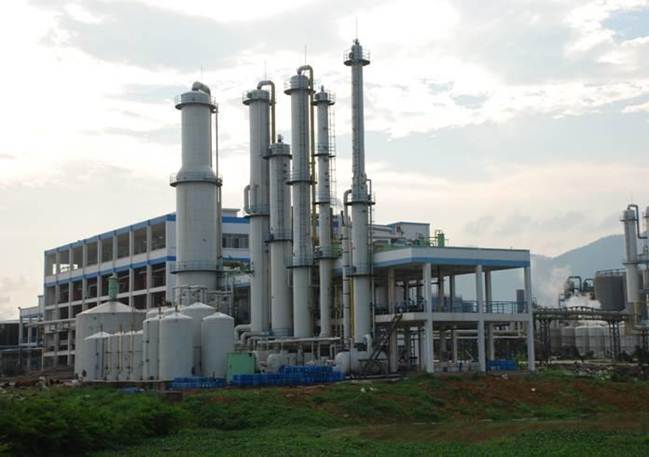I am still working on the weekly news roundup but in the meantime, the blog recently had a very interesting conversation with Green Biologics‘ vice president of business development, Tim Staub, on the company’s commercialization of its bio-based n-butanol.
It started when somebody from Arkema (via LinkedIn) was asking about current availability of bio-based n-butanol and Green Biologics posted that the company has just imported 55 tonnes of corn waste-based n-butanol produced by its partner, Laihe Rockley, in Jillin, China.
The world’s first commercial cellulosic n-butanol (as the company claimed) is now available for those who are interested in testing the product here in the US. The company is focusing on collaborative business model largely with major chemical downstream producers.
 |
| Laihe Rockley biobased n-butanol plant in Jilin Province, China |
Talking about upstream (which I know nothing about) Green Biologics said its results with most C5/C6 sugars regardless of feedstock are close to theoretical Clostridial yields (>80%) including cellulosic sugars. The company said the pretreatment work is mostly done by partners.
Staub said it has three different contracts in China but the company’s partner, Laihe Rockley, is the only one currently producing bio-based n-butanol at a 150,000 tonne/year plant (3 units each 50,000 tonnes) in Jilin Province.
Some interesting tidbit about the China biobased n-butanol market, according to Green Biologics, is that existing Chinese biobutanol capacity is said to exceed 300,000 tonnes/year, and is spread across over 6 sites and a number of smaller facilities across China.
One major biobased n-butanol producer based in China that the blog is familiar with is Cathay Industrial Biotech, which currently has a 100,000 tonne/year biorefinery in Jilin Province capable of producing 65-70% butanol, 20-25% acetone and 5-10% ethanol using corn for feedstock.
The company said it has currently reduced its n-butanol production because of high corn prices (about $10/bushel as of September).
Back to Green Biologics, the 55 tonnes of biobased n-butanol that the company imported from its Chinese partner was 100% of the plant’s production at the moment, according to Staub.
“It wasn’t a particularly long run and was designed more to generate data than volume. We are anticipating full commercial production in November or December, but ultimately that is up to Laihe Rockley.”
Green Biologics hope to see additional volume coming from the Jilin plant in 2013 although given high corn feedstock cost and logistics costs, the company wants to look into production in the US or Brazil.
“We started in China because the plants were there, the partners were there, and they were willing to pay for our technology, and it was a golden opportunity to demonstrate our technology at significant scale.”
Staub said the company is currently in the process of converting an ethanol plant in Iowa for a 500 tonne/year demonstration bio-butanol plant with two 40,000 liter fermenters. Green Biologics is also in discussion with two entities in Brazil for a possible biobased n-butanol project using sugarcane waste for feedstock.
According to this Bloomberg article in February, the original plan in Brazil was to produce 1,000 tonne/year biobased n-butanol. The company will focus its n-butanol for chemical application.
Another news in the bio-butanol world comes from a company that I’ve never heard of until now. According to Chemical Week (subscription), Michigan, US-based Working Bugs has begun producing biobased n-butanol at its 40,000 sq. foot fermentation facility in East Lansing.
Established in 2006, Working Bugs (interesting company name that is for sure…) is said to have already partnered with a large feedstock producing company, a company owning ethanol plants, and a large chemical company. Its university partner is Michigan Technological University.
The company said it has fermentation capacity ranging from lab scale to production scale with their largest fermenters having a volume of 16,000 liters (4,000 gallons). According to this US DOE permit last year, the 4,000 gallon-fermenter would contribute a minimum of 300 gallons/week of n-butanol production.
Their full production capacity goal is to develop a 7 fermenter line resulting in an n-butanol production capacity of 350-1,000 gal/week depending on the degree of optimization and how the line is run.
Bio-isobutanol producer Gevo, meanwhile, announced last week that it has been awarded US patent 8,238,505, which protects the company’s Integrated Fermentation Technology (GIFT). The patent includes a proprietary separation unit that is designed to enable cost-efficient separation of isobutanol from other components of the fermentation broth.
A week before this, Gevo has also been issued US Patent No. 8,273,565, entitled “Methods of Increasing Dihydroxy Acid Dehydratase Activity to Improve Production of Fuels, Chemicals, and Amino Acids.”
The new patent covers suppression of a glutaredoxin protein called GRX3. In combination with other Gevo patented technologies, deletion of GRX3 significantly increases the production of isobutanol by yeast cells, the company said.
The blog is anticipating Gevo’s third quarter conference call on October 30 to get further updates on the company’s bio-isobutanol production. If readers recall last month, Gevo announced that it has cut back its isobutanol production and instead will produce more ethanol to maximize cash flow.




One response to “Green Biologics’ biobutanol now available”
[…] a new technology for the production of renewable chemicals and biofuels. Green Biologics used alliances with Chinese giants such as Laihe Chemicals to take its technology from the laboratory to full-scale production facilities in a fraction of the […]